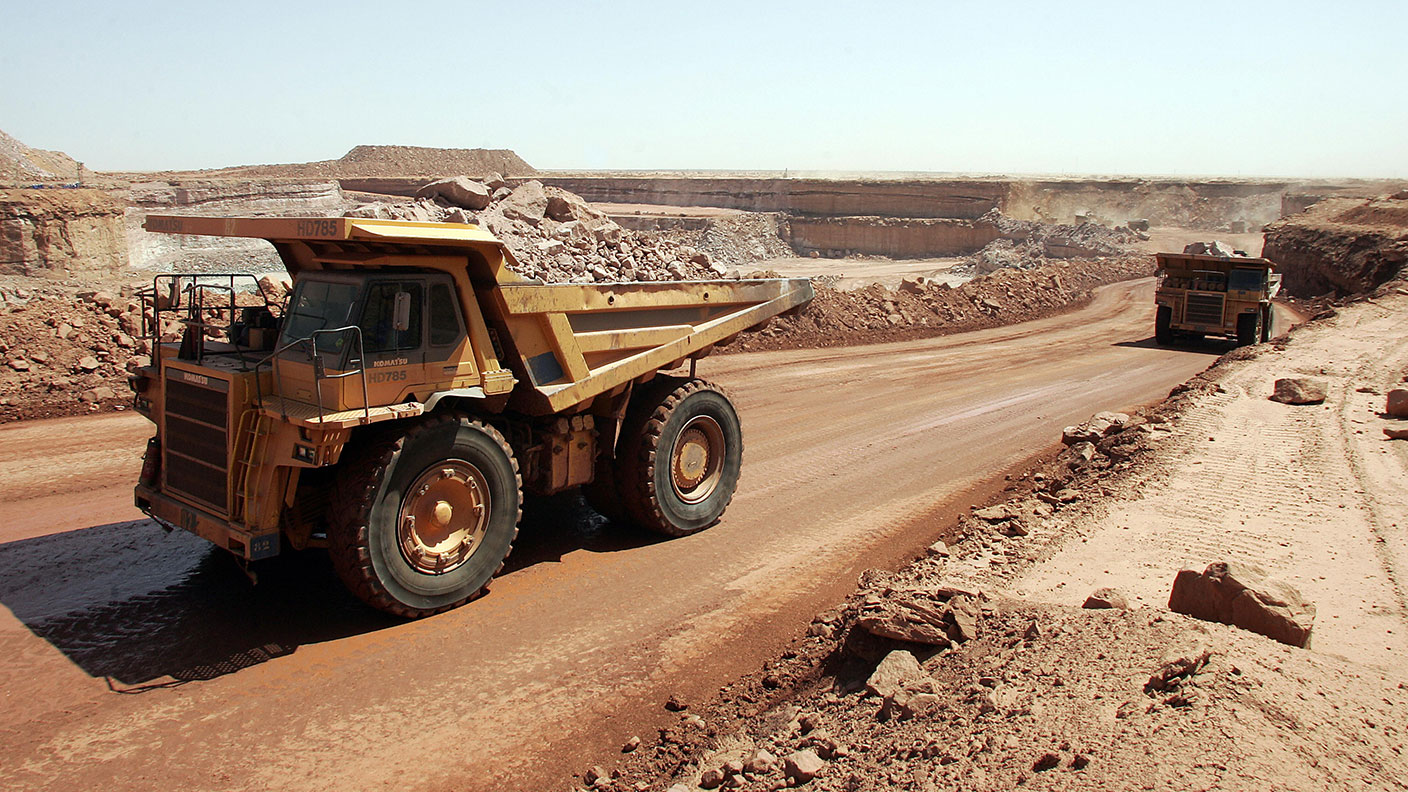The uranium price is soaring – here’s the best way to play it now
Uranium, the key ingredient to nuclear power, has been ignored since the bubble of 2006, but now the uranium price is rising again. Dominic Frisby explains the best way to invest.


Today we consider uranium.
An energy crisis is now looming, largely self-inflicted, caused by over-reliance on energy sources that are not reliable.
Meanwhile, uranium, the key ingredient to nuclear power, has gone through 15 years of under-investment, shunned since the bubble of 2006, when another looming energy crisis, (around the “peak oil” narrative) sent it moonwards.
MoneyWeek
Subscribe to MoneyWeek today and get your first six magazine issues absolutely FREE

Sign up to Money Morning
Don't miss the latest investment and personal finances news, market analysis, plus money-saving tips with our free twice-daily newsletter
Don't miss the latest investment and personal finances news, market analysis, plus money-saving tips with our free twice-daily newsletter
Now the uranium price and uranium stocks are rising again and, worryingly, uranium is all over the investment news.
Time to buy, or to run away? Perhaps a bit of both.
The demonisation of nuclear power means uranium will always be risky
Everyone should own some uranium in their portfolio. The potential is too enormous not to. “Asymmetric bets” and all that.
With the UN’s 2050 net zero target and the UK’s Climate Change Act, we are going to need much more electricity – for heating and for charging all those millions of electric vehicles. To meet these targets, the electricity supply will need to be both dramatically expanded and become much more reliable.
The solution lies in nuclear power. It can provide huge amounts of reliable, affordable, clean and almost infinitely renewable electricity. It’s such an obvious solution and investors will want to invest in it – that investment will enable us to get there quicker.
That is why everyone should own some uranium in their portfolio – because of its silver bullet potential. Yet we remain reliant on energy sources that are far less green, from fossil fuels to wind farms and solar, because the energy debate has been politicised and corrupted, often by those with their snouts in the trough of government subsidy.
Anti-nuclear campaigners have successfully persuaded most of the public, politicians and the media that nuclear energy is unsafe, despite the fact that it has the best safety record of any energy technology.
Environmental concerns, such as waste disposal, have largely been solved. Even environmentalists such as James Lovelock, author of Gaia Theory; Baroness Bryony Worthington, a lead author of the Climate Change Act; and activist Mark Lynas support it. But embracing uranium is too politically toxic for today’s career oriented politicians.
Because of the anti-nuclear propaganda, regulation now requires multiple layers of safety in nuclear plant design. The process is complex, slow, expensive and cumbersome and so takes years to complete. The long lead time between building and operation gets even longer and deters investment. Many recent proposals for nuclear power stations in the UK have been abandoned.
Then an incident such as Fukushima comes along, and the adoption of nuclear is put back another half generation.
That is why uranium as investment is shunned – and doomed.
The time to invest is when no one is talking about it. Not when everyone is, such as now, with the spot price spiking.
Uranium has great potential but now is not the best time to invest
Despite all the current excitement, it’s not as though there is a sudden rush to build more nuclear reactors (or if there is, I’ve missed it). There have been many false dawns in the uranium market – there was one in 2020. My concern is that this might be another.
The uranium spot price went from around $7 per pound at the turn of the century all the way to $140 in 2006 – when it moves, it moves fast. Uranium mining companies went up by even more than bitcoin. Then the bubble popped, and everything fell through the floor.
By 2010 it looked like a bottom had been found at around $40 and the price rallied to $70. It proved to be a suckers’ rally that was knocked out dead by the Fukushima disaster. That kicked off another price decline that went on for years, as bear markets do. By mid-2016 we were trading below $20.
But since then the price has found a bottom. It has spent a lot of time meandering around $20. It’s not going to go any lower than the 2016 lows, that much is clear. And it has started creeping up.
In 2018-2019 it ranged around $25. Post-Covid it spiked at over $30, then came back again to $28. Now suddenly it has spiked again and we are staring down the barrel of $50. It could almost triple and we would still only be around the 2006 highs. What happens if it goes above them? There’s a lot of potential.
One way to play this theme is through uranium mining companies. But many of the developers don’t actually do anything, they just sit on assets and raise money when the market gets hot – such as now. They are not going to start building mines until there is a change in regulation.
That will come eventually but, as I say, I have seen too many false dawns. Many miners have doubled or tripled in the last couple of months. They can quickly fall back to where they started. Don’t get FOMO (fear of missing out). Markets reward the patient. If you want to own uranium developers and explorers, and hold out for a re-rating, go for it – but wait until markets are asleep and boring.
The safest way to play uranium right now is through betting on the spot price of the metal itself – it’s less racy, but your risk is lower. London-listed Yellowcake Plc (LSE: YCA) has been set up with this purpose in mind. It is, basically, a uranium holding company – you buy the shares and hope that the value of its uranium stockpiles increases.
It is currently trading at £3.60 which gives it a market cap around $550m. It has 13,855,601 pounds of uranium. At $45/lb that’s $624m, plus another $90m in cash and assets, so $714m. At a $1.36 exchange rate that gives us a net asset value (NAV) of around £455m. So it’s trading at a premium.
There are times when it trades at a discount, so personally, I’d wait. But the downside of Yellowcake is considerably less that of a miner, so maybe, if you don’t own any, it’s worth a nibble.
You want to own some uranium in your portfolio; nuclear’s potential is enormous. But I’ve seen what happens with uranium stocks – fortune favours the patient.
Daylight Robbery – How Tax Shaped The Past And Will Change The Future is now out in paperback at Amazon and all good bookstores with the audiobook, read by Dominic, on Audible and elsewhere.
Get the latest financial news, insights and expert analysis from our award-winning MoneyWeek team, to help you understand what really matters when it comes to your finances.
Dominic Frisby (“mercurially witty” – the Spectator) is as far as we know the world’s only financial writer and comedian. He is the author of the popular newsletter the Flying Frisby and is MoneyWeek’s main commentator on gold, commodities, currencies and cryptocurrencies. He has also taken several of his shows to the Edinburgh Festival Fringe.
His books are Daylight Robbery - How Tax Changed our Past and Will Shape our Future; Bitcoin: the Future of Money? and Life After the State - Why We Don't Need Government.
Dominic was educated at St Paul's School, Manchester University and the Webber-Douglas Academy Of Dramatic Art.
You can follow him on X @dominicfrisby
-
 Investors will reap long-term rewards from UK equities
Investors will reap long-term rewards from UK equitiesOpinion Nick Train, portfolio manager, Finsbury Growth & Income Trust, highlights three UK equities where he’d put his money
-
 The graphene revolution is progressing slowly but surely
The graphene revolution is progressing slowly but surelyEnthusiasts thought the discovery that graphene, a form of carbon, could be extracted from graphite would change the world. They might've been early, not wrong.
-
 Investors should cheer the coming nuclear summer
Investors should cheer the coming nuclear summerThe US and UK have agreed a groundbreaking deal on nuclear power, and the sector is seeing a surge in interest from around the world. Here's how you can profit
-
 Halifax: House price slump continues as prices slide for the sixth consecutive month
Halifax: House price slump continues as prices slide for the sixth consecutive monthUK house prices fell again in September as buyers returned, but the slowdown was not as fast as anticipated, latest Halifax data shows. Where are house prices falling the most?
-
 Rents hit a record high - but is the opportunity for buy-to-let investors still strong?
Rents hit a record high - but is the opportunity for buy-to-let investors still strong?UK rent prices have hit a record high with the average hitting over £1,200 a month says Rightmove. Are there still opportunities in buy-to-let?
-
 Pension savers turn to gold investments
Pension savers turn to gold investmentsInvestors are racing to buy gold to protect their pensions from a stock market correction and high inflation, experts say
-
 Where to find the best returns from student accommodation
Where to find the best returns from student accommodationStudent accommodation can be a lucrative investment if you know where to look.
-
 The world’s best bargain stocks
The world’s best bargain stocksSearching for bargain stocks with Alec Cutler of the Orbis Global Balanced Fund, who tells Andrew Van Sickle which sectors are being overlooked.
-
 Revealed: the cheapest cities to own a home in Britain
Revealed: the cheapest cities to own a home in BritainNew research reveals the cheapest cities to own a home, taking account of mortgage payments, utility bills and council tax
-
 UK recession: How to protect your portfolio
UK recession: How to protect your portfolioAs the UK recession is confirmed, we look at ways to protect your wealth.
